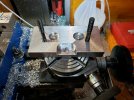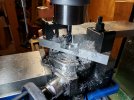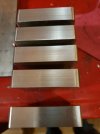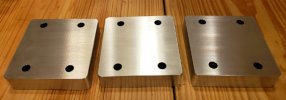Ian
Notorious member
I'm sure most people don't think much about it when they see a radius milled on the corner of a part made with a manual machine, but it takes some thinking, and a lot of tools to make it happen.
JimE gave me a brand new PM R8 keyless chuck and I'm going to make him some heater bases for his Lyman 45s. One thing that would really make them look clean is rounded corners, but I needed more tools to pull that off. I ended up buying a cheap 4" rotary table from Mao's Emporium and built a jig for it. First I cut a 6" piece of 3/4 x 3" 6061 aluminum and skimmed it flat on the shaper. Then I ground a V-groove tool and used the shaper to make a chevron pattern for eyeballing alignment. Then I turned a bolt into a pin that would pilot in the center hole of the table and center-drilled it, then turned the end to .251" for 3/8" so it would press into a 1/4" reamed hole and stop. After that I set up in the mill vise and drilled/reamed the centering pilot hole, then drilled and countersunk t-bolt holes for mounting to the table, then relieved some work space for the end mill that will be doing the work on the parts. After that I drilled and tapped two holes for clamping studs.

The center-drilled pin makes it easy to center the table under the spindle without using an indicator (close 'nuff for me) and also to center the radius off of a hole drilled accurately in the corner of a part if desired. The guide lines make it easy to clamp the part in squarely and evenly by eyeball. I still need to make some side guides for quickly repeating the same setup on multiple corners/partsband also need to find a way to easily get the corner of the part dead-center in line with the jig, but for now, here it is in action!

JimE gave me a brand new PM R8 keyless chuck and I'm going to make him some heater bases for his Lyman 45s. One thing that would really make them look clean is rounded corners, but I needed more tools to pull that off. I ended up buying a cheap 4" rotary table from Mao's Emporium and built a jig for it. First I cut a 6" piece of 3/4 x 3" 6061 aluminum and skimmed it flat on the shaper. Then I ground a V-groove tool and used the shaper to make a chevron pattern for eyeballing alignment. Then I turned a bolt into a pin that would pilot in the center hole of the table and center-drilled it, then turned the end to .251" for 3/8" so it would press into a 1/4" reamed hole and stop. After that I set up in the mill vise and drilled/reamed the centering pilot hole, then drilled and countersunk t-bolt holes for mounting to the table, then relieved some work space for the end mill that will be doing the work on the parts. After that I drilled and tapped two holes for clamping studs.

The center-drilled pin makes it easy to center the table under the spindle without using an indicator (close 'nuff for me) and also to center the radius off of a hole drilled accurately in the corner of a part if desired. The guide lines make it easy to clamp the part in squarely and evenly by eyeball. I still need to make some side guides for quickly repeating the same setup on multiple corners/partsband also need to find a way to easily get the corner of the part dead-center in line with the jig, but for now, here it is in action!




